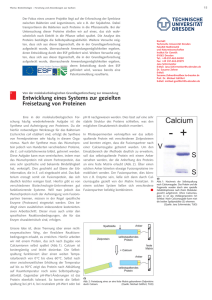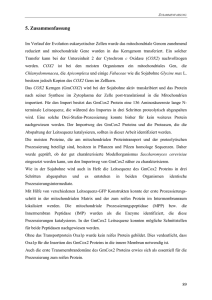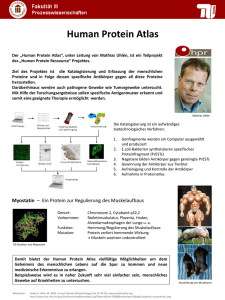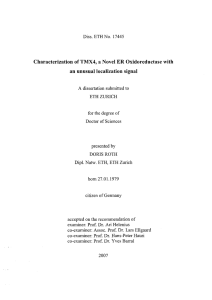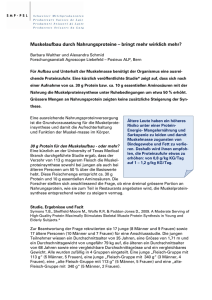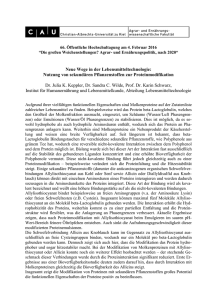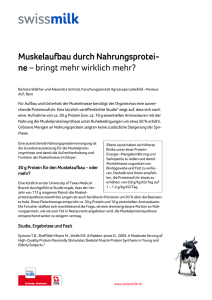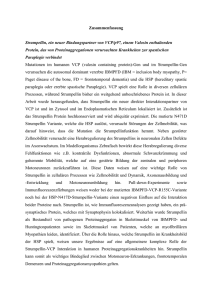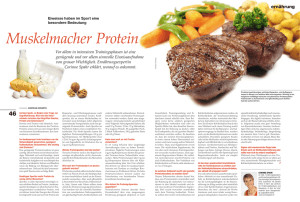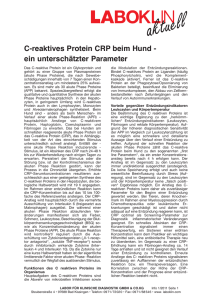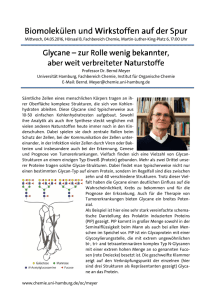DOWNLOAD Masterthesen
Werbung
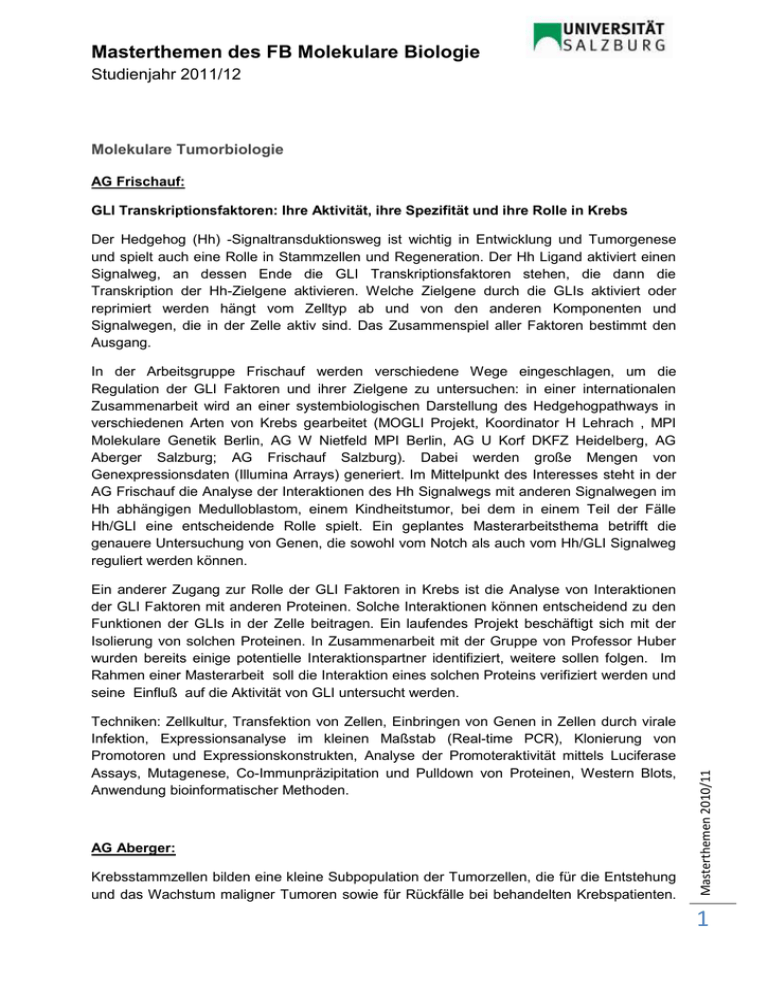
Masterthemen des FB Molekulare Biologie Studienjahr 2011/12 Molekulare Tumorbiologie AG Frischauf: GLI Transkriptionsfaktoren: Ihre Aktivität, ihre Spezifität und ihre Rolle in Krebs Der Hedgehog (Hh) -Signaltransduktionsweg ist wichtig in Entwicklung und Tumorgenese und spielt auch eine Rolle in Stammzellen und Regeneration. Der Hh Ligand aktiviert einen Signalweg, an dessen Ende die GLI Transkriptionsfaktoren stehen, die dann die Transkription der Hh-Zielgene aktivieren. Welche Zielgene durch die GLIs aktiviert oder reprimiert werden hängt vom Zelltyp ab und von den anderen Komponenten und Signalwegen, die in der Zelle aktiv sind. Das Zusammenspiel aller Faktoren bestimmt den Ausgang. In der Arbeitsgruppe Frischauf werden verschiedene Wege eingeschlagen, um die Regulation der GLI Faktoren und ihrer Zielgene zu untersuchen: in einer internationalen Zusammenarbeit wird an einer systembiologischen Darstellung des Hedgehogpathways in verschiedenen Arten von Krebs gearbeitet (MOGLI Projekt, Koordinator H Lehrach , MPI Molekulare Genetik Berlin, AG W Nietfeld MPI Berlin, AG U Korf DKFZ Heidelberg, AG Aberger Salzburg; AG Frischauf Salzburg). Dabei werden große Mengen von Genexpressionsdaten (Illumina Arrays) generiert. Im Mittelpunkt des Interesses steht in der AG Frischauf die Analyse der Interaktionen des Hh Signalwegs mit anderen Signalwegen im Hh abhängigen Medulloblastom, einem Kindheitstumor, bei dem in einem Teil der Fälle Hh/GLI eine entscheidende Rolle spielt. Ein geplantes Masterarbeitsthema betrifft die genauere Untersuchung von Genen, die sowohl vom Notch als auch vom Hh/GLI Signalweg reguliert werden können. Techniken: Zellkultur, Transfektion von Zellen, Einbringen von Genen in Zellen durch virale Infektion, Expressionsanalyse im kleinen Maßstab (Real-time PCR), Klonierung von Promotoren und Expressionskonstrukten, Analyse der Promoteraktivität mittels Luciferase Assays, Mutagenese, Co-Immunpräzipitation und Pulldown von Proteinen, Western Blots, Anwendung bioinformatischer Methoden. AG Aberger: Krebsstammzellen bilden eine kleine Subpopulation der Tumorzellen, die für die Entstehung und das Wachstum maligner Tumoren sowie für Rückfälle bei behandelten Krebspatienten. Masterthemen 2010/11 Ein anderer Zugang zur Rolle der GLI Faktoren in Krebs ist die Analyse von Interaktionen der GLI Faktoren mit anderen Proteinen. Solche Interaktionen können entscheidend zu den Funktionen der GLIs in der Zelle beitragen. Ein laufendes Projekt beschäftigt sich mit der Isolierung von solchen Proteinen. In Zusammenarbeit mit der Gruppe von Professor Huber wurden bereits einige potentielle Interaktionspartner identifiziert, weitere sollen folgen. Im Rahmen einer Masterarbeit soll die Interaktion eines solchen Proteins verifiziert werden und seine Einfluß auf die Aktivität von GLI untersucht werden. 1 verantwortlich ist. Die gezielte medikamentöse Hemmung von Krebsstammzellen stellt eine der vielversprechendsten Therapiemöglichkeit dar. Ein wesentliches Ziel der AG Aberger ist, jene molekularen Mechanismen aufzuklären, die für das Wachstum, die Selbsterneuerung und das Überleben von Krebs(stamm)zellen verantwortlich sind. Der Fokus liegt dabei auf der funktionellen Analyse des Hedgehog/GLI Signalweges, der eine wesentlich Rolle in der Entstehung einer Vielzahl humaner Krebsformen spielt. 1. Interaktion onkogener Signalwege mit der Hedgehog/GLI Signaltransduktion in der Entstehung von Hautkrebs Mit Hilfe transgener Mausmodelle in Kombination mit einer breiten Palette von ergänzenden in vivo und in vitro Analysen soll untersucht werden, welche Rolle verschiedene Hedgehogmodulierende Signalwege wie EGFR, MEK/ERK oder PI3K/AKT in der Krebs-Entstehung spielen. Weiters soll in in vivo Tumormodellen untersucht werden, inwieweit die kombinierte Hemmung der Hedgehog Signaltransduktion und ausgewählter modulierender Signalwege therapeutische Anwendung finden könnte. 2. Hedgehog Signaltransduktion in Krebsstammzellen: Entwicklung effizienter KombiTherapien in präklinischen Modellen Das kooperative Zusammenspiel unterschiedlicher Krebsgene und onkogener Signalwege für zur Etablierung maligner Expressionsprofile. In Vorstudien konnte eine Reihe sogenannter potentieller „drug targets“ identifiziert werden, deren Funktion eine wichtige Rolle in tumor-initiierenden Krebsstammzellen verschiedener Krebsarten (zB Pankreas und Kolonkarzinom) spielt. Durch Kombination geeigneter medikamentöser Krebstherapeutika sollen synergistisch wirkenden onkogenen Signale gehemmt werden, um tumor-initiierende Krebszellen möglichst effizient zu attackieren und somit einen deutlich verbesserten therapeutischen Nutzen zu erzielen AG Krammer: Photodynamische Therapie und zelluläre Biophysik Weltweit werden seit über 35 Jahren verschiedene Tumore und nicht-maligne Erkrankungen auf inneren und äußeren Körperoberflächen mit PDT behandelt. Unser Schwerpunkt liegt in der Untersuchung der molekularen und zellulären Mechanismen der Zellschädigung und der verschiedenen Zelltodarten, welche zur Tumorbeseitigung und Immunität nach PDT führen. Weiters forschen wir u.a. an Verbesserungen der Photosensibilisator-Anreicherung (drug delivery) in den Zellen, z.B. mittels Nano-Carriern, und an Verbesserungen der Bestrahlungsmodalitäten. Themen in Bearbeitung: Masterthemen 2010/11 Die Photodynamische Therapie (PDT) ist eine effektive, nachhaltige und nebenwirkungsarme Therapie zur Beseitigung von Tumoren, entzündlichen Erkrankungen und auch Mikroorganismen und wird in vielen Ländern schon seit Jahren erfolgreich durchgeführt. Das Wirkprinzip ist die Aktivierung einer nicht-toxischen Substanz, eines Photosensibilisators, in z.B. einer Tumorzelle oder in einem Blutgefäß durch sichtbares Licht zu einer hochreaktiven Substanz am Ort der Bestrahlung. Durch Bildung verschiedener reaktiver Sauerstoffformen wirkt der aktivierte Photosensibilisator letal auf das Target und/ oder stimulierend auf Signalübertragungswege und das Immunsystem. 2 Diagnose von Tumorzellen für Tumorzellapherese mittels photodynamischem Prinzip; Diagnose von Plattenepithelkarzinomen bei EB-Patienten; molekulare Grundlagen von Hautdefekten (z.B. Epidermolysis bullosa); Ansätze zu neuen Tumortherapien, z. B. mittels Einsatz von Nanopartikeln; Phototoxizität neuer, natürlich vorkommender Photosensibilisatoren und deren Modulation von intrazellulären Signalübertragungswegen; Rotlichteffekte bei Wundheilung und Entzündung, Untersuchung der Heileffekte der Gasteiner Radontherapie an Zellmodellen. Wir führen sowohl Grundlagenforschung für die klinische Anwendung gemeinsam mit medizinischen Einrichtungen und ausländischen Kooperationspartnern, als auch angewandte Forschung in Kooperation mit Kliniken und Firmen durch. Neue Diplomthemen: 1) Photodynamische Tumortherapie als Modulator von pro-inflammatorischen Cytokinen Vorallem eine subletale Anwendung von PDT, wie bei der Diagnose üblich, kann proinflammatorische Cytokine wie IL-6 heraufregulieren. Wir wollen nach PDT mit den Photosensibilisatoren Hypericin und dem endogen gebildeten Protoporphyrin IX die Modulation der Cytokine IL-1beta, IL-6, TNF-alpha, etc. in mehreren Zelllinien untersuchen. Dazu werden die Zellen im Grundzustand oder nach Stimulation einer proinflammatorischen Reaktion verwendet. Umgekehrt soll ein möglicher Effekt eines pro-inflammatorisch erhöhten Zustandes auf die Effizienz der PDT analysiert werden. 2) Photodynamische Tumortherapie zur Induktion einer anti-Tumor Immunantwort: die Rolle von DAMPs PDT konnte in vorhergegangenen Maus-Versuchen einen Tumor vollständig beseitigen und eine effektive anti-Tumor-Immunantwort einleiten. Wir wollen die molekularen Mechanismen zur Stimulation des Immunsystems über die Analyse der relevanten DAMPs (damageassociated molecular pattern) aufklären. Dazu zählen proinflammatorische Cytokine und Heatshock Proteine. 3) Nanovehikel für lipophile Photosensibilisatoren Lipophile Photosensibilisatoren wie die Naturstoffe Hypericin (aus dem Johanniskraut) oder Curcumin (Cucuma longa) besitzen zwar gute Eigenschaften in der Modulation von Pathways und Beseitigung von Tumorzellen, werden aber nur schlecht in wässriger Phase bis zu den Tumorzellen transportiert. Sie müssen daher mit „Transportmitteln“ (z.B. Nanopartikeln) oder Löslichkeitsverstärkern (z.B. PVP) verbunden werden. Hier sollen speziell entworfene Nanovehikel zur Aufnahme von Photosensibilisatoren in Tumorzellen untersucht werden. Molecular Plant Biophysics and Biochemistry AG Obermeyer: Das Hauptinteresse unserer Forschung liegt in der Erforschung der zellulären Prozesse, die für die Auskeimung und das anschließende Wachstums des Pollenschlauches verantwortlich sind. Das Pollenschaluchwachstum ist ein fundamentaler Prozeß der pflanzlichen Masterthemen 2010/11 Weitere Themen werden aktuell bekanntgegeben (z.B. über Aushang). 3 Befruchtung. Nur eine erfolgreiche Befruchtung sichert die Produktion von Nahrungsmitteln für die Ernährung der Weltbevölkerung. Eine zentrale Frage ist, wie kann sich ein Pollenschlauch im drei-dimensionalen Raum orientieren und wie erfolgt das gerichtete Wachstum zum Ovarium? Zur Beantwortung dieser Fragen werden molekularbiologische, biochemische und biophysikalische Techniken verwendet, um die Funktion von unterschiedlichen „Schlüsselproteinen“ zu klären und schließlich diesen Prozess mittels theoretischer Modelle zu simulieren (systems biology). Dabei wird auch die physiologischen Funktion von Pollenallergenen untersucht, die auch höchstwahrscheinlich auch bei der Pollenschlauchkeimung beteiligt sind: was ist ihre ursprüngliche Funktion im Pollen und wie werden sie hinausgeschleust? 1. Pollen Organelle Membrane Proteome (POMP): Mit Hilfe massenspektrokopischer Methoden kann die Gesamtheit aller Proteine im Pollen oder spezifischen Pollenorganellen untersucht werden. Das POMP zeigt eine hohe räumliche sowie zeitliche Dynamik im Laufe des Keim- und Wachstumsprozesses des Pollenschlauches. Membranproteine (Ionentransporter) und das Membrane trafficking spielen bei den meisten zellulären Prozessen eine wichtige und zentrale Rolle. In diesen Prozessen konnten auch die meisten Schlüsselproteine, die die Polarität induzieren bzw. aufrechterhalten, identifiziert werden. die für das Pollenschlauchwachstum essentiell sind, durch Bindung an phosphorylierte Epitope. Identifizierte 14-3-3 Isoformen aus Lilienpollen sollen in Bakterien exprimiert und aufgereinigt werden. Die gereinigten, rekombinanten 14-3-3 Proteinen können dann gezielt für Bindungsexperimente eingesetzt werden. Aufgrund ihres unterschiedlichen pIs und Molekulargewichtes können die natürlichen 14-3-3 Proteine mit Hilfe der 2-dimensionalen Gelelektrophorese aufgetrennt und identifiziert werden und somit können mögliche Veränderungen im Isoformmuster während der Pollenschlauchkeimung beobachtet werden. Masterthemen 2010/11 2. Molekulare Schalter: 14-3-3 Proteine regulieren die Aktivität unterschiedlicher Proteine, 4 3. Transport: Mit Hilfe verschiedener elektrophysiologischer Methoden können Ionenströme in intakten Pollenkörnern und –schläuchen (2-Elektroden voltage-clamp) aber auch Einzelkanalströme an Pollenprotoplasten (patch-clamp) gemessen werden. Durch eine genaue Charakterisierung der Eigenschaften dieser Ströme können Ionenkanäle oder – pumpen identifiziert werden. Neben dem Transport von Ionen spielt der Transport von Wasser während der Rehydratisierung des Pollenkorns und des Verlängerung des Pollenschlauches eine wichtige Rolle. Die Aufnahme des Wassers ist somit sehr eng mit dem Pollenschlauchwachstum, aber auch mit der Freilassung der Allergene verknüpft. Funktioniert diese Wasseraufnahme mittels Aquaporine, wie wird der Turgordruck reguliert und wie kann man den Transport von Wasser überhaupt messen? 5. Pollenallergene: Die Aufgabe von Pollenallergen ist nicht ihre Allergenizität, sondern hat etwas mit der physiologischen Funktion des Pollen zu tun. Weshalb werden allergene Proteine aus dem Pollen freigesetzt während andere im Cytosol verbleiben? Mit Hilfe rekombinanter sowie gereinigten, natürlichen Pollenallergenen soll in unterschiedlichen Experimenten dieser Frage nachgegangen werden, dabei sind vor allem Art v 1, das Hauptallergen des Beifußpollen und das Panallergen Polcalcein von Interesse. Mögliche Themen: 1. Aquaporine im Pollen: Expression und Charakterisierung (Molekularbiologie, Biochemie) 2. Protein-Protein-Interaktion der PM H+ ATPase mit regulatorischen Proteinen (Biophysik, Biochemie) 3. Turgordruckmessungen an Pollenkörnern (Biophysik) 4. Einzelkanalmessungen an der Plasmamembran von Pollen-Protoplasten (Biophysik) 5. Isolierung von sekretorischen Vesikeln aus Pollenschläuchen (Biochemie, Proteomics) 6. Identifizierung von t-SNARE-Proteinen für die Vesikelfusion mit der Plasmamembran (Biochemie) 7. CSI Ca2+ ATPase: Charakterisierung, Sequenz und Isolierung (Molekularbiologie, Biochemie) 8. Herstellung eines rekombinanten Ca2+-Bindeproteins aus Lilienpollen (Molekularbiologie, Biochemie) 9. Interaktome des K+ Kanals (Biophysik, Zellbiologie) 10. Transformation von Pollenkörnern (Molekularbiologie) fluoreszenz-markierten Ionentransportern in Pollenkörnern Chemie und Bioanalytik AG Huber: 1. Untersuchung der toxischen Auswirkungen potentieller neuer Medikamente auf humane Zellmodelle auf der Ebene des Proteoms und Metaboloms: Masterthemen 2010/11 11. Expression von (Molekularbiologie) 5 Die Einführung und behördliche Zulassung eines neuen Medikaments dauert viele Jahre und erfordert einen immensen Investitionsaufwand. In der Entwicklung neuer therapeutischer Wirkstoffe werden tausende Substanzen hergestellt und im Hinblick auf ihre Wirkungen und Nebenwirkungen im Menschen untersucht. Im Zuge dieses Verfahrens ist es besonders wichtig, toxische Wirkungen von Substanzen möglichst früh festzustellen, um Sie umgehend aus dem Verfahren ausschließen zu können. In diesem Projekt des 7. EURahmenprogrammes versuchen wir, toxische Wirkungen von neuen Substanzen durch ihre Auswirkungen auf die Protein- und/oder Metabolitenzusammensetzung in menschlichen Modellzellen (z. B. Nierenzellen oder Hepatozyten) zu charakterisieren. Dazu sind mit Hilfe von mehrdimensionalen chromatographischen Trenntechniken und Massenspektrometrie so genannte Protein-Maps sowie mit der hochaufgelösten Massenspektrometrie MetabolitenProfile zu erzeugen, aus denen mit Hilfe bioinformatischer Methoden DosisWirkungsbeziehungen und mögliche toxische Wirkungen abgeleitet werden. 2. Massenspektrometrische Charakterisierung von intakten Proteinen: Aufgrund der leichteren Handhabbarkeit und der einheitlicheren physikalisch-chemischen Eigenschaften werden Proteine heute vielfach erst nach einem Verdau zu Peptiden analysiert. Dies hat den Nachteil, dass viele Protein-spezifische Informationen, z. B. Sequenzvarianten oder posttranslationale Modifikationen, verloren gehen. In diesem Projekt versuchen wir, die Analysenmethodik auf der Ebene intakter Proteine weiterzuentwickeln. Dazu werden leistungsfähige chromatographische Trenntechniken in Verbindung mit der Massenspektrometrie eingesetzt. Für die empfindliche Detektion der Proteine müssen die experimentellen Parameter sorgfältig optimiert werden. Um einen Nachweis geringster Mengen an Proteinen (Bruchteile von Picogramm = 10-9 g) zu ermöglichen, müssen die Analysentechniken auch entsprechend miniaturisiert werden. Anwendung finden die entwickelten Methoden in der Erstellung von Toxizitätsprofilen (siehe Thema 1) sowie in der Analyse von Proteinen, die an der Signaltransduktion beteiligt sind. Rekombinante Allergenprodukte werden zunehmend in der Diagnostik und der spezifischen Immunotherapie (Hyposensibilisierung) von Allergien eingesetzt. Eine korrekte Diagnose und maßgeschneiderte Dosierung des Allergens im Zuge der Hyposensibilisierung setzt eine umfassende Charakterisierung rekombinanter Allergenprodukte voraus. Dies betrifft die Reinheit des Produkts und die Identifizierung eventueller Verunreinigungen ebenso wie den Nachweis der korrekten Proteinfaltung und intakter Epitope. Als Alternative zu Routinemethoden wird die Kapillarelektrophorese (CE) als innovatives Trennverfahren im Mikromaßstab eingesetzt. Eine Kombination unterschiedlicher Trennmodi der CE sowie eine Kopplung mit der Massenspektrometrie dient einer Absicherung der Ergebnisse. Der Nachweis geringster Änderungen in der Aminosäuresequenz, des Faltungszustands sowie abweichender posttranslationaler Modifikationen der Allergene, erfordert umfassende Optimierungen der CE-Trennungen. Der aktuellste Ansatz umfasst eine Wechselwirkung zwischen Allergenen und spezifischen monoklonalen Antikörpern im Zuge der elektrophoretischen Trennung. Die entwickelten Methoden dienen einer verbesserten Standardisierung der Allergenprodukte im Zuge der Qualitätssicherung. Mikrobiologie AG Weßler: Stomach cancer is the second leading cause of cancer-related deaths worldwide. Even after early diagnosis, the prognosis of gastric carcinoma is rather poor due to its high capability to metastasize, since no treatments to prevent cancer spread are available. Gastric cancer is Masterthemen 2010/11 3. Kapillarelektrophorese von Allergenen: 6 closely linked to persistent Helicobacter pylori infection in humans. Accordingly, the World Health Organization has defined H. pylori as a class-I carcinogen (comparable to asbestos and smoking). The model of gastric cancer development involves of a typical series of sequential processes, initiated by chronic active inflammation in response to H. pylori infection at the early phase in carcinogenesis followed by loss of gastric glands, atrophy and hyperproliferation. Finally, there is a progressive loss of differentiation inducing invasive growth of individual neoplastic cells. In vitro, infection of gastric epithelial cells with H. pylori induces a drastic cell migration and changes in cell morphology, cell-cell and cell-matrix adhesions (Fig. 1) that might contribute to inflammatory processes, wound healing, angiogenesis, invasive growth or metastasis in vivo. However, the molecular mechanisms are largely unknown. Fig. 1: The EMT-like phenotype observed in H. pylori-infected gastric epithelial cells. AGS cells were infected with H. pylori (right) at a MOI 100 or left untreated (left) for 8 hours followed by laser scan microscopy to monitor changes of the cellular morphology and the actin cytoskeleton (red). Nuclei are stained with DAPI (blue). Hence, in our project, we investigate these cellular processes which are differentially regulated by defined pathogenic factors of H. pylori. Those factors are either presented on the bacterial surface, secreted into the environment or injected into the host cytoplasm where they interfere with host cell responses. The cytotoxin-associated gene A (CagA) is a well studied paradigm among pathogenic factors. CagA is injected via a type IV secretion system (T4SS) from H. pylori directly into the cytoplasm of infected host cells. The T4SS itself and the injected CagA then behave as ´eukaryotic´ signaling molecules and selectively activate signal transduction pathways contributing to the H. pylori-associated pathogenesis. Other important pathogenic factors include the secreted protease HtrA (high temperature requirement A) that disrupts intercellular adhesions, adhesions that enables H. pylori attachment or VacA (vaculating cytotoxin A) which induces large vacuoles in cultured epithelial cells and promotes apoptotic effects. Working at the interface between microbiology and cell biology, we are interested in the cellular aspects of pathogen-host interactions. This knowledge will deepen our understanding of the complex intracellular signal transduction pathways in host cells leading to a strong inflammatory response and carcinogenesis in the stomach. Available projects are on following topics: Analysis of H. pylori-induced signal transduction pathways that selectively transactivate the promoter of important target genes: Many genes encoding cytokines, gastrin or other pro-inflammatory factors are tightly controlled by H. pylori. Here, we analyze the upstream signal transduction pathways (initiated by receptors, involvement of small GTPases and kinase cascades), activation of transcription factors and promoter of target genes. Loss of intercellular adhesions and bacterial proteases: H. pylori secretes the protease HtrA as a novel pathogenic factor that cleaves the cell adhesion protein E-cadherin on host cells. Ectodomain shedding of E-cadherin has drastic consequences on the integrity of Masterthemen 2010/11 The EMT-like phenotype induced by H. pylori: The morphological phenotype of H. pyloriinfected cells (Fig. 1) resembles growth factor-induced EMT (epithelial-mesenchymal transition) that often occurs during cancer invasion and metastasis. We are investigating several cancer-associated pathways inducing EMT leading to dedifferentiation of cells to elucidate how H. pylori stimulates the EMT-like process and which pathways are involved. 7 adherence junctions and intracellular signal transduction pathways that control the actin cytoskeleton. Methods: microbiological and molecular techniques, culture of tumor cells and pathogens, infection experiments, Western blotting, kinase assay, protein overexpression and purification, immunofluorescence analysis, transient transfection, reporter gene experiments, real-time PCR analysis, ELISA, etc. Bioinformatik AG Sippl: Our main research interest is to understand the rules of protein folding. This requires (1) to classify all known protein folds in terms of pairwise structure similarities and (2) to find out how the information contained in the amino acid sequences is translated into threedimensional structures and how these structures endow the proteins with their respective characteristic chemical functions and biological roles. At the Division of Bioinformatics we address these problems by two major research projects. The first is COPS, our Classification of Protein Structures. In the second project we use the known structures to deduce the atomic and molecular forces that are responsible for the folding and stability of protein structures and we use the resulting energy functions to find and correct errors in experimental protein structures and predict and compute protein structures from their amino acid sequences. There are many interesting problems that need to be solved and there are many as yet undetected rules and features that need to be investigated. The research projects below are suitable for a master thesis. Students will become acquainted with tools and methods of bioinformatics, including (indispensable) programming skills in Python/C. Recent publications and further information on COPS and our energy functions can be found on our web page: http://www.came.sbg.ac.at. The evolution of sequences and structures The evolution of protein domains Proteins can be decomposed into structurally compact subunits called domains. These domains are generally thought to be independent folding units (i.e. the structure only depends on the sequence of the respective domain and is independent of other parts of the protein chain). Moreover, domains frequently duplicate and are exchanged between proteins by recombination processes. Although the structures of such domains are very similar their sequences often seem to be unrelated even if they are contained in the same protein. On the other hand, since the diverged sequences encode for very similar structures there must be some common information on the sequence level that gives rise to this structural similarity. Masterthemen 2010/11 The evolution of proteins is driven by changes in amino acid sequences. At present we know a subset of rules (structure is more conserved than sequence, similar sequences generally have similar structures, etc.) of protein evolution but the picture is still incomplete. The goal of this project is to use sequence and structure alignment techniques to quantify the differences in the conservation of sequences on the one hand and the conservation of structures on the other. Based on our COPS data base this will allow us to characterize and quantify how protein structures adapt to changes in amino acid sequences. This is likely to reveal exciting new insights regarding the relationship between amino acid sequences and protein structures and as such it will be a significant contribution to the advances in structural biology and bioinformatics. 8 Furthermore, the topic of protein domains is strongly connected to protein function. Frequently, domains are defined on the level of chains (or tertiary structure). However, numerous examples show that distinct compact subunits of protein structures can only be assigned when the physiologically functional protein (quaternary structure, biological assembly) is considered. There are many intriguing questions that will be addressed in this project using COPS and the bioinformatics tools we have in our hands: (1) Why are amino acid sequences changing so quickly after domain duplication? (2) What is the common sequence information that determines the related structures of domains whose sequences have strongly diverged? (3) What can we learn about the evolution of protein structures from domains derived from biological assemblies? (4) When building structural domains from biological assemblies, it is crucial that the underlying data is not erroneous. How can we detect faulty biological assemblies? How can correct biological assemblies be built? Is it possible to detect faulty domain decompositions with existing tools? Fold recognition The experimental determination of protein structures by X-ray crystallography or Nuclear Magnetic Resonance (NMR) spectroscopy is still a tedious and time-consuming task. Hence, a lot of effort has been spent in bioinformatics for the development of algorithms that predict protein structure from sequence. One principle commonly adopted is to identify a protein of known structure that is supposed to resemble the structure of the query sequence. The structure found (the template) is then used to build a model of the unknown structure (the target). Many algorithms for structure prediction rely on a high sequence similarity between target and template, but with the growth of protein structure databases it became clear that there are many similarities amongst protein structures that have only marginal sequence similarity. Fold recognition techniques try to find template structures that would have been missed by common sequence search methods. The goal of this master thesis is to integrate an already existing fold recognition algorithm with the framework of COPS and apply it to the prediction of various interesting protein structures. Protein structure and function COPS and sequence databases Only a portion of all currently available protein sequences have a known three-dimensional structure. The topic of this work is to provide a list of sequences that have no significant sequence similarity to a sequence with known structure using the COPS classification, thus covering all sequences with no detectable structural relative. The list changes every week because COPS is concurrent with the Protein Data Bank which is weekly updated. Such a list provides difficult sequences for computional methods like fold recognition and protein structure prediction as well as for experiments like Structural Genomics and CASP. A Masterthemen 2010/11 A basic assumption in protein function prediction is that similar structure implies similar function. In COPS we have a lot of examples of similar structures at various degree of sequence similarity. The topic of this work is an analysis of such cases. At what degree of structural similarity and how often is it possible to derive function? Does sequence similarity play a major role in this game? One application is the annotation of targets from Structural Genomics projects. There are many Structural Genomics targets of unknown function that share structural similarity with already annotated structures. Is it possible to annotate these proteins of unknown function using structural similarity? 9 particularly interesting application is the analysis of the human proteome with respect to how much structural information can currently be obtained for its sequences. Peaks and pitfalls in local protein structure The goal of this master thesis is to identify unrealistic molecular environments in protein structures (by application of an already implemented method) and *thoroughly* check if these unrealistic environments are due to errors in the process of protein structure determination, format errors in the corresponding Protein Data Bank files or are a consequence of seldomly occurring chemical restraints (non-standard bondings, ligands, experimental conditions like pH value and temperature, ...). The master student working on this thesis should be strongly interested in organic chemistry and literature research concerning the analyzed proteins. The first steps of this work will include a guided introduction to the method that has to be applied and the selection of a number of unrealistic physico-chemical environments in protein structures which shall be analyzed in detail. Strukturbiologie AG Schwarzenbacher: 1. NLR-proteins in Immunity and Inflammation Recently a new family of highly conserved, intracellular receptors which follows the TLRparadigm has been discovered and dubbed NLRs. Like TLRs, NLRs recognize foreign products such as peptidoglycans and initiate host defense pathways, through the activation of inflammatory caspases and subsequent release of IL-1b and IL-18. Mutations in NOD1, for example, are implicated in Blau syndrome a form of uveal, skin and joint granulomatous inflammation, whereas NOD2 mutations are associated with Crohn's disease and ulcerative colitis, two major forms of inflammatory bowel disease affecting over one million people in North America and Europe alone. Therefore, our main goal is to identify the structure, ligands, binding partners and signalling mechanisms of these crucial immune receptors and their role in innate immunity and inflammation. 2. Alpensalamander www.alpensalamander.eu Zelluläre Passkontrolle: präsentation Antigenprozessierung und – Das Immunsystem hat die Aufgabe, äußere Eindringlinge (Viren und Bakterien) und innere Fehlentwicklungen (Tumoren) zu erkennen und gegebenenfalls zu bekämpfen. Dazu muss sich jede Zelle dem Immunsystem gegenüber ausweisen, indem es Peptide aus dem Zellinneren an der Zelloberfläche präsentiert. Trotz der enormen Effizienz dieses Fahndungssystems gelingt es einzelnen schädlichen Zellen unentdeckt zu bleiben, weil unauffällige Peptide präsentiert werden, und dadurch die Passkontrolle versagt. Wir untersuchen Masterthemen 2010/11 AG Brandstetter: 10 den komplexen Protease-Apparat, der für die Peptidgenerierung verantwortlich ist. Ein eingehendes Verständnis dieser Prozessierungswege verspricht gezielte Eingreifmöglichkeiten zur Behandlung von Tumor- und Infektionserkrankungen. Undercover unterlaufen Agenten – wie Krankheitserreger zelluläre Abwehrmechanismen Eine klassische Strategie von Pathogenen ist die Imitation von Proteasen der Immunabwehr. Dadurch werden die Schutzmechanismen des Wirtsorganismus unterlaufen. Wir untersuchen in diesem Zusammenhang bakterielle Kollagenasen, die bei Infektionen einen entscheidenden Beitrag zur Kolonisation und Infiltration des Wirts leisten. Allergien Allergene sind an sich harmlose Fremdproteine, die aber bei rund 20 % der Bevölkerung eine übermäßige Immunantwort auslösen und zu vielfältigen Symptomen führen, die von Juckreiz bis zum anaphylaktischen Schock reichen können. Doch was macht ein Protein zu einem Allergen? Mithilfe struktureller Untersuchungen konnten wir ein Modell der molekularen Metamorphose erstellen, das erklärt, warum Allergene eine allergische Immunantwort auslösen: Allergene wandeln ihre Erscheinungsform durch intramolekulare Umlagerungen und durch intermolekulare Komplexbildung (Oligomerisierung) um, wodurch Schlüsselereignisse wie Endozytose, proteolytische Prozessierung, Antigenpräsentation sowie Antikörpererkennung und –quervernetzung beeinflusst werden. Die Unterdrückung dieser Metamorphose stabilisiert Allergene in einer Erscheinungsform und stellt somit einen hochspezifischen Therapieansatz dar. Weitere Details finden Sie auf www.uni-salzburg.at/xray. In dem skizzierten Themenkreis bieten sich in unserem Labor Möglichkeiten für folgende Masterarbeiten: 1. Etablierung eines Aktivitätsassays und enzymkinetische Charakterisierung von (z.B. antigenprozessierenden) Proteasen Virologie/Glykobiologie AG Vlasak All living cells express large numbers of glycans at their cell surface. Glycans are found as Nglycans and O-glycans on proteins. In addition, they are found as part of glycosylphosphatidylinisotol (GPI) anchors, on glycolipids, and as glycosaminoglycans. The biosynthesis of glycans involves numerous enzymes and sugar transporters. Although many of the key enzymes have been identified, relatively little knowledge on the regulation of their activity is available. On the other hand it is well documented that glycosylation is species- Masterthemen 2010/11 2. Klonierung, Expression, Reinigung und Kristallisation eines Zielproteins aus den oben dargestellten Themenbereichen 11 specific, organ-specific, and even cell type-specific. Glycans are involved in self-recognition (e.g. blood group antigens), and they are important players in the regulation of the immune system. Furthermore, glycan structures often change during disease. In cancer, several glycan structures are either over expressed or down regulated. Many viruses use specific glycans as receptors for docking to the cell surface, thereby initiating an infection. In our group, we have characterized the binding specificities of the receptor-binding proteins of influenza viruses, coronaviruses and toroviruses. They selectively bind to different forms of an acid sugar termed “sialic acid”. Thus, they represent so called “lectins” (sugar-bindig proteins). In the near future we want to use these proteins as probes to detect sialic acids on serum glycoproteins. They will be included into “lectin-arrays” on ELISA plates and used to identify differences in the glycosylation patterns of cancer patients. In another project, we have established a protocol to genetically modify influenza C viruses. Here, we will now further investigate the role of the viral nonstructural protein NS1 in its interference with the cellular interferon response. Our aim is to knock out this protein without disturbing its RNA splicing activity, thereby creating an attenuated virus which cannot replicate in normal tissue, but only in certain types of cancer, e.g. melanoma. Since human melanoma over express receptors for influenza C viruses, attenuated forms are good candidates for future use as tumor-destroying (oncolytic) viruses. Techniques: Cell culture, protein expression and purification, glycan analysis, ELISA assays, lectin binding assays, site-directed mutagenesis, reverse genetics. Topics for master thesis: Expression and purification of viral lectins Determination of the stability and selectivity of lectins coupled to ELISA plates Determination of the minimal requirements for splicing activity of the influenza C virus NS1 protein Creation of viable influenza C viruses with NS1 deletions which are able to replicate in human melanoma cells Allergie und Immunologie AG Thalhamer: The research of the AG Thalhamer includes (i) basic science with the goal of eliciting cellular and molecular mechanisms of the immune responses triggered by specific protein and gene vaccines, and (ii) translational research focused on the development of vaccines for the treatment of allergy. Concerning the former aspect, the group is interested in various triggers which polarize the immunity or lead to a tolerogenic state. This is of particular interest for both, the understanding of the nature of allergenic molecules and their possibly inherent allergenicity, Masterthemen 2010/11 Gene and protein vaccines - prophylactic and therapeutic approaches for the treatment of allergic diseases 12 as well as for the development of anti-allergic approaches. The primary targets to investigate these questions are the skin and the mucosal surfaces. A large panel of up-to-date molecular biological and immunological methods is used thus providing the master students with an internationally competitive theoretical and practical knowledge. The translational part of the research programs includes the development of gene-based and protein vaccines with novel application modes, such as transdermal immunization via laserporated skin or mucosal application to modulate immune responses. Topics of research include: 1. RNA vaccines for prophylactic vaccination against allergies We have demonstrated that gene vaccines effectively protect from the induction of allergic immune responses by inducing a TH1 biased immune milieu. We could show for the first time that RNA vaccines are as effective in preventing sensitization than their DNA counterparts and due to their short persistence represent a safe alternative for prophylactic vaccination. In collaboration with the Blutbank Linz of the Red Cross Oberösterreich, we are currently investigating whether TH1 biased immune responses, as they are induced by RNA vaccines, resemble an immune profile that is found in non-atopic humans who have grown up in a farming environment. Today, the majority of vaccines is administered by the intramuscular route using hypodermic needles and syringes, even though muscle is not a highly immunogenic organ. Development of effective methods for vaccine delivery to the skin is considered a feasible approach. The skin represents an important peripheral immune organ attractive for vaccination as it is rich in immunocompetent cells including Langerhans cells, dermal dendritic cells and keratinocytes, and its efficient drainage to lymph nodes. An ideal skin vaccination method should therefore be reliable, but also eliminate the dangers and pain associated with hypodermic needles. In collaboration with Pantec Biosolutions, we established a precise laser epidermal system (P.L.E.A.S.E.) for vaccine application via lasergenerated micropores. We could recently demonstrate that specific immunotherapy via Masterthemen 2010/11 2. Transcutaneous immunization via laser generated micropores 13 P.L.E.A.S.E. is equally effective compared to subcutaneous injections but induces a more favourable cytokine profile. Current research includes the evaluation of different adjuvants for skin immunotherapy and application of the technology for a broader panel of vaccines, including Hepatitis B, meningococcal disease, and haemophilus influenzae. 3. Role of Langerhans cells in gene gun induced immune responses Langerhans cells (LC) are antigen presenting cells (APC) found predominantly in the skin and mucosal epithelia. Owing to their ideal anatomic location, LC have long been regarded as a prototypic example of professional APC. Although the role of LC for immune activation or modulation is now being discussed controversially, other langerin+ dendritic cells (DC) appear crucial for protective immunity in a growing set of infection and vaccination models. In knock-in mice that express the human diphtheria toxin receptor under control of the langerin promoter, langerin+ cells can be specifically ablated by injection of diphtheria toxin allowing investigating the role of these cells in various immunological settings. A B C Fluorescent staining of epidermal sheets from LangDTR mice without (A, B) or with (C) diphtheria toxin. α-I-A/I-E-FITC (A, C); α-CD3-PE (B). Josef Thalhamer encourages interested candidates to contact him via email ([email protected]) and to make an appointment for the discussion of detailed projects, applications and employment. AG Duschl: The main function of professional antigen presenting cells (APCs) such as dendritic cells (DCs) is the induction of adaptive cellular immune responses. Upon antigen encounter, DCs provide specific signals to naïve T-cells and thus promote the differentiation of particular Thelper (Th) cell subsets which are generated to control different types of protective immune responses. The question how the immune-system decides which type of T-cell mediated immune-response to launch against particular pathogens or other stimuli still puzzles immunologists. DCs, the most potent type of antigen presenting cells, seem to play a central role in this process and are in the focus of our research interest. Recently, we have identified Interleukin 31 (IL-31) and SOCS2, two molecules that were so far not associated with DC-biology, to be involved in DC activation. IL-31, one of the lastly identified cytokines is closely related to the family of IL-6 cytokines and was shown to be associated with dermatitis and atopic inflammation of the skin. SOCS2 is a member of the Suppressor Of Cytokine Signalling (SOCS) proteins and was so far mainly thought to regulate growth hormone dependent signalling pathways. Studies from our own group provide evidence that both proteins are involved in the regulation of DC activation. To investigate immune modulatory effects of IL-31 and SOCS2 in DCs in terms of Th cell Masterthemen 2010/11 1. 1. IL-31 and SOCS2 – novel key regulators of dendritic cell - functions? 14 activation a position would be available for a master student. The main methods involved are generation of human dendritic cells from peripheral blood, RNA isolation, RT-PCR, western blotting, ELISA, flow cytometry and siRNA based gene silencing in DCs. 2. Impact of nanoparticles on human immune cells Nanotechnology is one of the fastest growing technologies in the last years, many advantages and new products to improve our life are promised. Currently, more than 1000 products containing nanotechnology are already on the market. Thus, there is an increasing demand to fully understand all possible interaction of these new engineered nano-entities with biological subjects. We are interested in the interaction of engineered nanoparticles with human immune cells, which are investigated within EU-funded studies. Master students may participate in these ongoing projects. Nanowires and lung cells. Picture by Linda Stöhr Oxidative stress is often seen as one of the major mechanism in nanoparticles-induced health effects. Within this thesis, the role of specific nanoparticles parameters like composition, shape, surface area, surface chemistry on the induction of reactive oxygen species and the activation of inflammatory pathways will be investigated. Furthermore, the specific kind of stress response will be examined using FACS measurements, western blotting, ELISA and luciferase measurements using stably transfected cell lines. Specific mechanisms of cell-nanoparticle interaction are an interesting subject for a master thesis. AG Ferreira: Masterthemen 2010/11 3. Investigation of stress response in immune cells after exposure to engineered nanoparticles 15 Type I allergies, which comprise a wide range of IgE-mediated disorders such as hay fever, asthma, atopic dermatitis, affect more than 20% of the population and therefore represents a major health problem. In an allergic reaction, allergen-specific IgE antibodies bound to the surface of mast cells and basophils via high-affinity Fcε receptors serve as the receptor for the allergen on mast cells and basophils. Cross-linking of these cell surface-bound IgE antibodies by allergen represents the signal for the release of pre-formed and newly synthesized inflammatory mediators such as histamine, leading to the typical allergic inflammatory reaction. Although allergen-specific immunetherapy (SIT) is the only curative approach for type I allergies, in its present form SIT is performed with allergen extracts and is accompanied with risk of IgE-mediated side effects. Systems for recombinant production of allergens and techniques for gene manipulation offer unique tools for the development of novel molecule-based products to be used in diagnosis and SIT. Pure and standardized recombinant allergens or cocktails prepared thereof and containing most of the IgE-binding epitopes of an allergen source can be formulated to replace natural extracts. The primary interest of our group is the development of new tools for allergy diagnosis and for safer and more efficient allergen-specific immunotherapy. Presently, we are working on birch pollen and associated food allergies, allergic reactions to mountain and Japanese cedar, ragweed, and mugwort pollen allergies. In addition, hypersensitivity reactions against nonsteroidal anti-inflammatory drugs (like Diclofenac, etc) are investigated with the aim of development of new diagnostic tools for drug-induced anaphylaxis. To generate improved tools for allergy diagnosis and therapy, our ongoing projects involve: Masterthemen 2010/11 • Identification of natural allergens • Generation of low IgE binding hypoallergenic molecules in bacterial, yeast and plant expression systems • Protein purification • Physicochemical protein characterization (analysis of protein folding and aggregation, mass spectrometry) • Immunologic characterization of recombinant proteins in vitro • Antigen uptake and processing • Analysis of allergenic molecules in pre-clinical models • Basophil activation test for detection of drug-induced hypersensitivity by FACS 16 Therefore we are constantly looking for diploma students and interns participating in ongoing research projects. AG Briza: With the develpoment of modern tandem mass spectrometers, proteomic research became an increasingly important tool to identify and characterize proteins in complex samples. Basically, two complementary approaches are possible. Proteins are extracted from cells or organelles, digested with protease and the resulting peptides are separated by reverse phase HPLC and analyzed by a directly coupled tandem mass spectrometer. The other option is to separate the extracted proteins by oneor two-dimensional gel electrophoresis, digest protein spots with protease and analyze the peptides by MS. Tandem MS instruments are able to simultaneously aquire peptide masses and peptide fragmentation patterns. With this information, proteins can be unequivocally identified in protein data bases. Sequence information obtained for unknown proteins can be used for cloning the corresponding genes. Our group uses a Micromass Global Ultima Q-Tof (quadrupole - time-of-flight) mass spectrometer with electro spray ionizatiion, optionally coupled with a capillary HPLC. AG Lackner: Immunoinformatik Den größten Teil der Allergene machen Proteine aus. Von vielen dieser allergenen Proteine ist mittlerweile die Raumstruktur bekannt. Wo dies nicht der Fall ist, kennt man zumeist die Struktur eines homologen Proteins. Die Raumstrukturen dienen als Basis um grundlegende Fragen der Allergieforschung zu beantworten, aber auch um therapeutische, sog. Hypoallergene zu entwickeln. Diese Forschungsarbeiten werden in enger Zusammenarbeit mit den experimentellen Gruppen von F. Ferreira und J. Thalhamer durchgeführt. Masterthemen 2010/11 Using the methodology described above, we try to identify new proteins or protein isoforms that induce type I allergies in allergic patients. Our main focus are allergens from tree (birch and selected trees) and weed (mugwort, ragweed) pollen. Our work is done in close cooperation with the group of Fátima Ferreira. 17 Mit bioinformatischen Methoden wird versucht, der Antwort auf die große Frage "Was macht ein Protein zum Allergen" ein Stück näher zu kommen. Dabei ergeben sich viele Detailfragen wie: Habe Allergene charakteristische Strukturen? Habe allergene Proteine charakteristische Oberflächeneigenschaften? Wie werden allergene Proteine in APCs prozessiert, welche T-Zell Epitope ergeben sich? Was sind die potentiellen B-Zell Epitope? Parallel dazu wird aber auch der Frage nachgegangen, wie kann man ein Allergen gezielt so verändern, das es (in Form eines Hypoallergenes) für therapeutische Zwecke verwendet werden kann. Eine computerbasierte Methode beruhend auf der 3D Struktur des Allergens, wurde dazu bereits entwickelt und erfolgreich angewandt. Methodisch steht also die Strukturbioinformatik im Mittelpunkt. Zum einen werden öffentlich zugängliche Programme verwendet. So z.B. MODELLER zum Erstellen von 3D Modellen von Proteinen, für die es bislang keine experimentelle Struktur gibt. Oder Prosa2003 für die Modellevaluierung oder die Berechung von Hyperallergenen. Chimera, ein mächtiges Molekülgrafikprogramm, dient als Arbeits-plattform, in welche die genannten Programme integriert werden, um effizient mit den Daten umgehen zu können. In Rahmen von Diplomarbeiten besteht nun die Möglichkeit, verschiedenste Detailfragen zu klären, vorhandene Methoden zu adaptieren und zu optimieren, einzelne Methoden zu einer Pipeline zu integrieren aber auch an der Entwicklung neuer Lösungen mitzuarbeiten. Bei Diplomarbeiten kann je nach Interesse und Begabung daher entweder die Anwendung von BI-Software im Mittelpunkt stehen oder aber auch das Entwickeln von Methoden. Alle Diplomanden erlernen den Umgang mit verschiedenen Programmen, Linux, und ggf. Programmiertechniken um dann selbstständig eine konkrete gestellte Aufgabe lösen zu können. Einige der verwendeten Methoden/Services werden in den LVAs 'Biologische Datenbanken', 'Anwendungen der Bioinformatik' und 'Immunoinformatik I+II' vorgestellt. Grundkenntnisse der Programmiersprache Python werden im Kurs 'Programmieren für Biologen' vermittelt. Als ideale Entscheidungshilfe für eine Diplomarbeit wird eine AG angeboten. Masterthemen 2010/11 Erwartet wird von Diplomanden: Interesse an der Immunologie und Interesse in Bioinformatik und Proteinstrukturen, Freude an der Computerarbeit und die Bereitschaft auch nichtbiologische Techniken wie Programmieren in Grundzügen zu erlernen. 18
